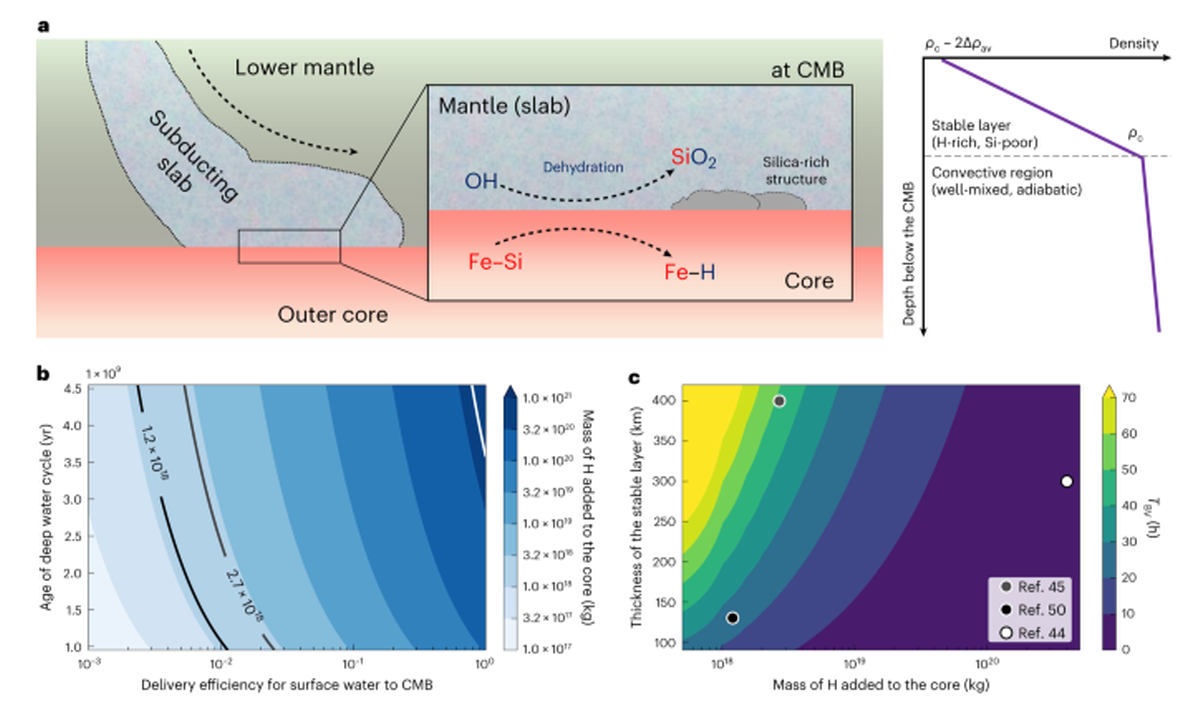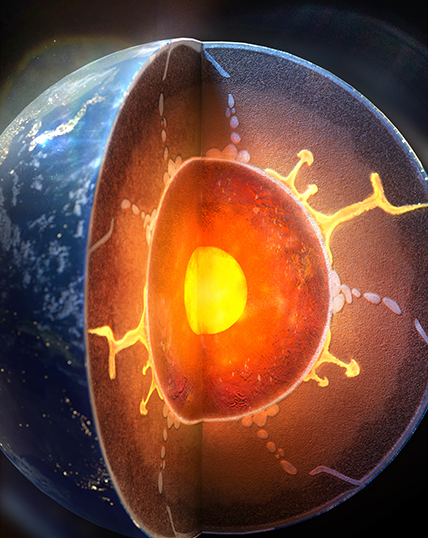A New Model of Earth's Outermost Core Presented by Prof. Yongjae Lee’s Team
Reaction of water and iron at the boundary between the core and mantle reveals
a hydrogen-rich outermost layer of the outer core
World's first explanation of the formation of the uppermost seismic low-velocity layer in the core

Professor Yongjae Lee of the Department of Earth System Sciences (Institute for High-pressure Mineral Physics and Chemistry) and his team have published a new study showing that water that has traveled deep into the mantle can react with iron, the main component of the core, to form a hydrogen-rich layer at the top of the Earth's outer core.
The findings were published on November 13 (local time) in Nature Geoscience (IF 18.3), the world's leading journal on the earth sciences.
This study, conducted in collaboration with Professor Sang-Heon Shim at Arizona State University, USA, and his team, is the first to explain the formation of a low-velocity layer previously thought to exist at the top of the core. It shows that many of the same complex reactions and structures that occur at the Earth's surface can also occur in the deepest parts of the Earth, at the boundary between the core and mantle.
The Earth's core consists primarily of iron, but it also contains some lighter elements such as silicon, oxygen, sulfur, and hydrogen, which reduce the overall density of the core and maintain the core's convection, which is key to the formation of the Earth's magnetic field, for longer periods of time. In particular, the molten outer core is in direct contact with the rocky mantle, forming a boundary at a depth of about 2,900 kilometers.
In the past, material exchange was considered to be limited at the boundary between the core and mantle, but recent studies have shown that water from the surface can be incorporated into minerals in subducting tectonic plates and transported deep into the mantle. Professor Yongjae Lee’s team expected that the composition of the core would be affected if water were to reach the interface between the core and the mantle, just as water weathers rocks at the surface.
To study the reaction of iron and water at the boundary between the core and mantle, the team used a small high-pressure generator called a diamond anvil cell and an infrared laser to create conditions of high pressure of about 1.3 million times atmospheric pressure and high temperature of more than 4,000 °C. A very small, bright X-ray beam from a radiation photon accelerator was used to observe the reaction.
Under these experimental conditions, the hydrogen component of the water bonded with the iron, and the silicon component previously present with the iron reacted with the oxygen component of the water and converted into a dense phase of silica. This exchange reaction formed a light, hydrogen-enriched top layer of the outer core and a high-density silica-enriched bottom layer of the mantle.

In this study, the mechanism of the low-velocity layer at the top of the outer core was described, assuming that approximately 1% of subducted water reaches the core–mantle boundary in the form of stable hydrous minerals and that this process has been ongoing for about 2.5 billion years. "As a result of these cumulative elemental exchange reactions, there may now be a stable layer hundreds of kilometers thick at the top of the outer core that holds about 1,000 trillion tons of hydrogen," said Arizona State University professor Shim, who collaborated on this study.
"The Earth has been constantly changing its surface from the past to the present through the formation and movement of tectonic plates," said Professor Lee. "This study suggests that these dynamic movements and changes have been occurring not only at the surface but also at the deepest boundaries of the Earth."
This study was conducted with financing from a grant from the Leader Researcher Support Project (Institute for High-pressure Mineral Physics and Chemistry) of the National Research Foundation of Korea (NRF). The high-temperature and high-pressure X-ray diffraction experiments using the laser heating of a diamond anvil cell were performed at the radiation accelerator research facilities of the Argonne National Laboratory (ANL) in the United States and the German Electron Synchrotron (Deutsches Elektronen-Synchrotron; DESY) in Germany.
Find out more:
Title of original: A hydrogen-enriched layer in the topmost outer core sourced from deeply subducted water
Journal: Nature Geoscience
DOI: https://doi.org/10.1038/s41561-023-01324-x
Contact corresponding author: Prof. Yongjae Lee (yongjaelee@yonsei.ac.kr)
Recommended Articles
Professor Byeong-Su Kim
New study demonstrates that “deformable” electronics are not a stretch
Professor Yeonjin Yi